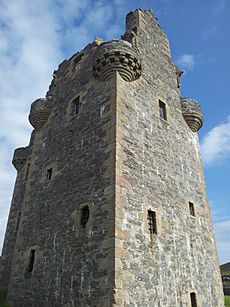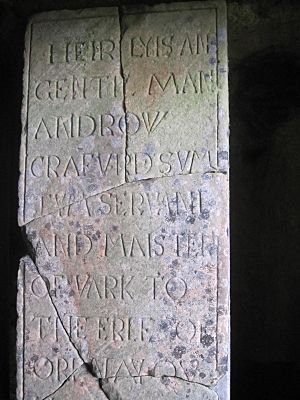Scalloway Castle facts for kids
Scalloway Castle is an old tower house found in Scalloway, on the Shetland Mainland. This is the biggest island in the Shetland Islands of Scotland. A tower house is a strong, tall building that was used as a home and for defense. Patrick Stewart, 2nd Earl of Orkney, built this castle around the year 1600. He was in charge of Shetland for a short time.
Contents
History of Scalloway Castle
Early Rulers of Shetland
In 1564, a man named Robert Stewart was given land in Orkney and Shetland. He was the son of King James V. Robert became a very powerful person in the islands. However, he was not always fair. Many people complained that he took their land and used taxes wrongly.
Even with these complaints, King James VI later made Robert Stewart the Earl of Orkney and Lord of Shetland. The local landowners did not like him. They managed to turn the king against Robert. He lost his title in 1587 and died without much money in 1593.
Patrick Stewart Takes Over
Robert Stewart's son, Patrick, became Lord of Shetland in 1590. He did not get along with his father. When his father died, Patrick took over as Earl of Orkney in 1600. In Shetland, Patrick also took land from people. He often argued with the local landowners. One of his main rivals was Laurence Bruce of Cultmalindie.
Building the Castle
After becoming Earl in 1600, Patrick Stewart started building Scalloway Castle. It was finished around 1607. Patrick's main home was the Earl's Palace in Orkney. Scalloway Castle was used by his representative in Shetland. It was also a meeting place for the local parliament, called the "thing," when Earl Patrick was in charge.
Workers were forced to build the castle without pay. They came from all over Shetland. Andrew Crawford, Patrick's master builder, supervised the work. Crawford likely also built Patrick's Earl's Palace in Kirkwall. He also built Muness Castle on Unst for Bruce of Cultmalindie.
The Castle After Patrick Stewart
In 1609, the Shetland landowners complained to the king about Earl Patrick's unfair rule. Patrick was put in prison in Edinburgh. He was later executed in 1615. This happened because he encouraged his son Robert to try and take back his Orkney lands.
After Patrick, James Law, the Bishop of Orkney, took control of the islands. He held his first court at Scalloway Castle in August 1612. In 1653, soldiers were stationed at the castle. By the early 1700s, the castle was in poor condition. Some of its fancy stone parts were moved to a nearby house called the Haa of Sand.
The castle ruins were taken care of by the state in 1908. Today, Historic Scotland looks after them. Digs in 1979 and 1980 found remains of other buildings from the 1600s near the tower.
What Scalloway Castle Looks Like
Scalloway Castle has an L-shape. The main part of the tower is about 18 meters long and 10 meters wide. A smaller wing on the south-west side is about 8 meters square. The castle no longer has a roof. It has four main floors, plus an extra small room at the top of the main tower.
The ground floor has a curved, tunnel-like ceiling. This floor held kitchens, storage rooms, and a well. A straight staircase leads up to the main hall on the first floor. Spiral stairs then go up to the floors above. Around the third floor, there are small corner towers called bartizans. These stick out from the walls and are supported by decorative stone brackets called corbelling.
Above the main door, there used to be an inscription. It is hard to read today. But in the 1700s, it was recorded as: "Patrick Stewart, Earl of Orkney and Shetland. James V King of Scots. That house whose foundation is on a rock shall stand but if on sand shall fall..." This castle is now a protected historical site.




